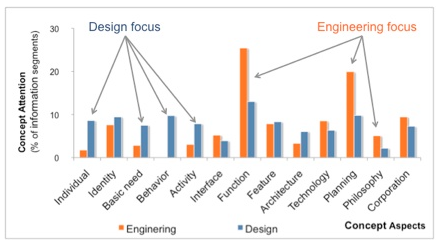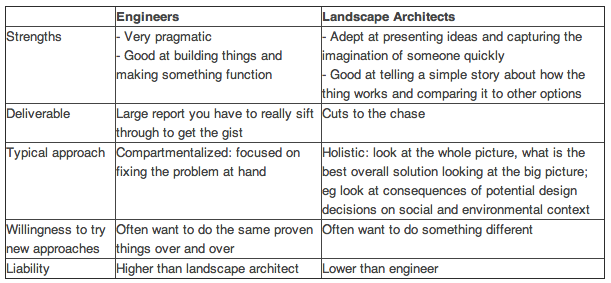Designers + engineers = better products
Why Designers and Engineers is a Match Made in Heaven – post about the benefits of designers and engineers collaborating on projects from their inception.
Designers and engineers depend on each other to create innovative, trendsetting and sustainable solutions for humanity. Only a few decades ago, the average design department just designed and then threw their concepts over the wall to the engineering department for the engineers to somehow make it work. Today, successful product development firms simultaneously design and engineer products from the outset, improving product quality while reducing development time and cost.
The writer mentions two studies comparing the thinking process of designers and engineers that support the idea of collaboration and “cross-functional learning” leading to improved product design.
When analyzing their concept descriptions, designers were found to focus on the users’ in the social context, needs, behavior and activities, while engineers focused on function, planning and philosophy. While this may come as no surprise, where they do come together is on their thinking about the users’ identity, interface, features, architecture, technology and the corporate context.
For a good summation of the issue see Report on the NSF Workshop: Collaborative Practice: When Engineering Design Meets Architecture, a 2010 workshop at the University of Pennsylvania supported by the National Science Foundation, in their section on why they had the workshop:
The borders between the design disciplines of architecture and engineering design, particularly in terms of their accepted methodologies for research and practice, remain unclear. Each discipline tends to operate as if their methods and customs were universally applicable. Each has the tendency to speak primarily to those who share their native language and core beliefs … This lack of cross-border respect and comprehension presents an obvious obstacle to true collaboration.
Nevertheless, current trends in practice provide a platform from which to address these obstacles to collaboration. BIMs and BOMs, virtual prototypes, immersive environments, modeling and validation, digital design and fabrication, brainstorming and design charrettes — while the applications may differ, architects and engineers are now using many of the same tools and techniques for design. Today’s shared practices provide a unique opportunity for these two disparate groups to find a common language through which to talk about design. A shared language may also allow us to overcome many of the historic barriers that have hindered effective collaboration between these two disciplines. Meanwhile, important issues such as environmental sustainability, energy conservation, and global competitiveness are cutting across traditional disciplinary boundaries, and the potential for synergy as engineers and architects attempt to address these difficult challenges is tremendous. …
This workshop was motivated by the belief that the greatest potential for discovery and transformational innovation in the design of buildings exists at the contested border between engineering and architecture design practices. … the most innovative findings, methods, and products are likely to come at the intersection of disciplines, rather than–in the case of engineering and architecture–by either operating in isolation.
For examples of recent collaboration, not just between designers and engineers, but also artists and other designers, see the GOOD post We Can Work It Out: Architecture + Collaboration.
Here’s a chart from Are Landscape Architects & Engineers Frenemies? on the differing perspectives of landscape architects and engineers, especially when it comes to using trees in stormwater infrastructure:


